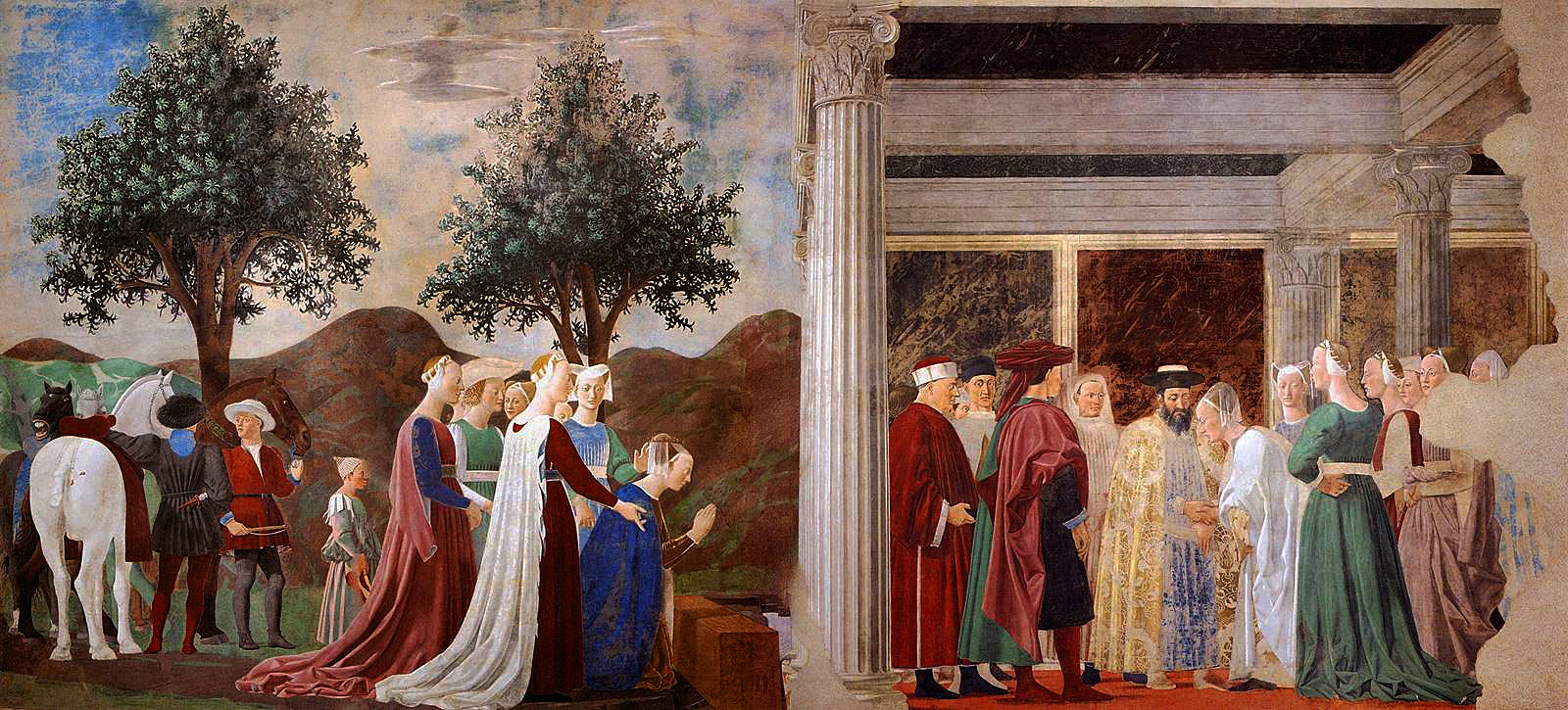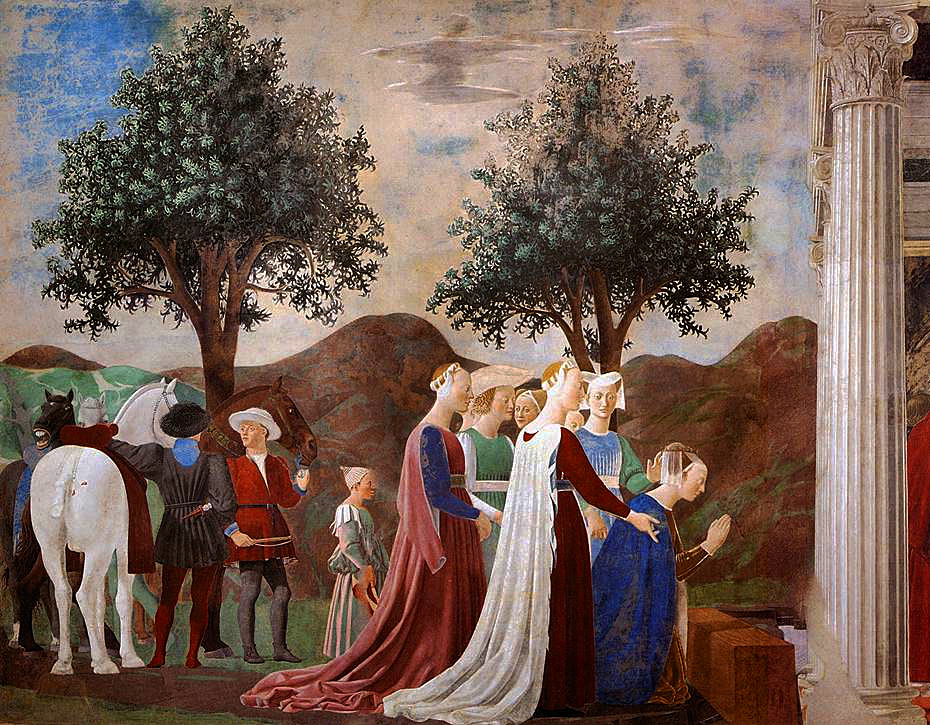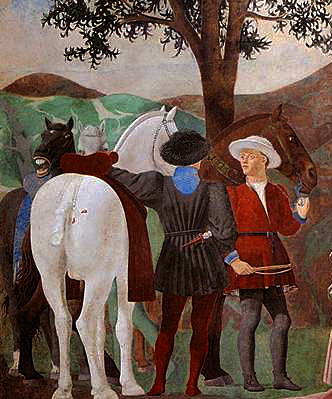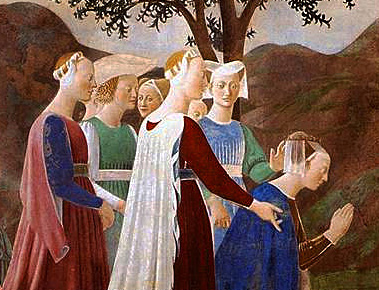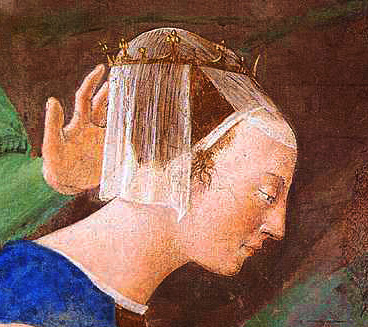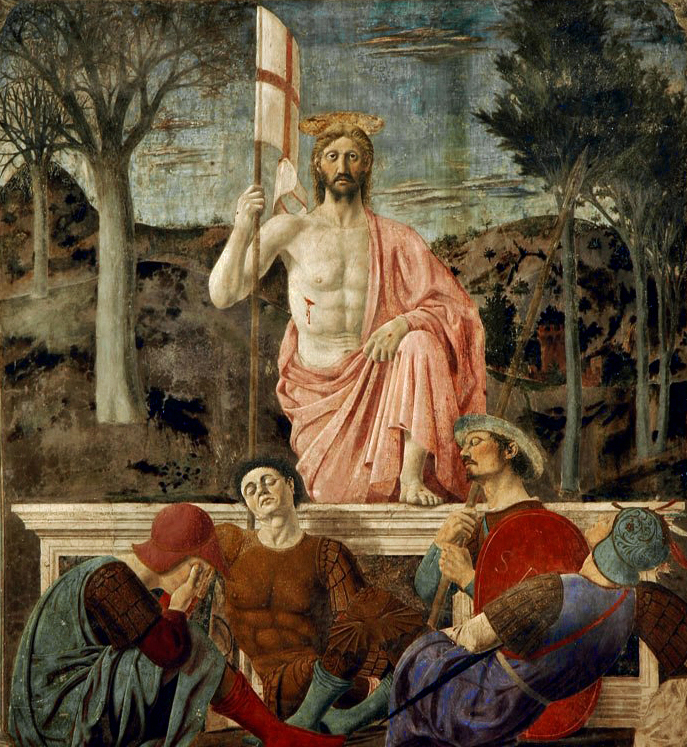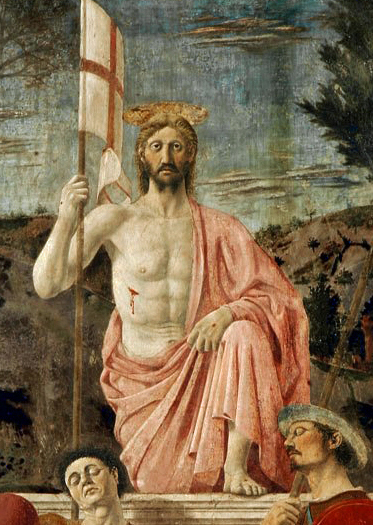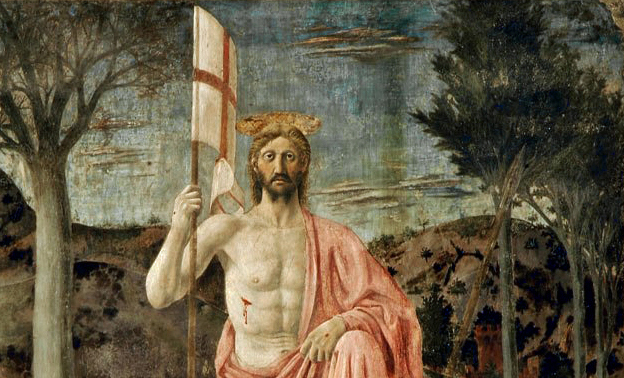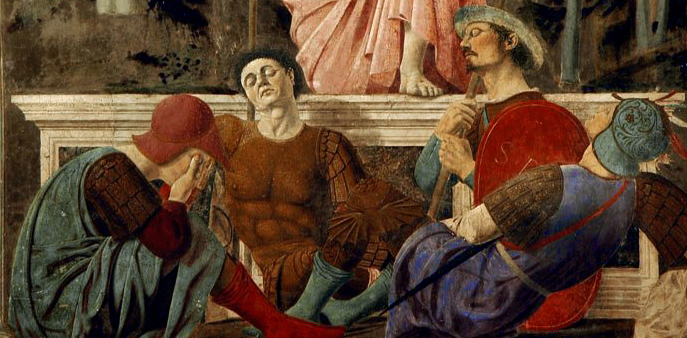By Dorothy Koppelman
In honor of the Piero della Francesca 600th anniversary celebration, the Terrain Gallery is proud to present this important talk given in 2007 at the Piero della Francesca Foundation in Sansepolcro, Italy (Italian translation here). Lia Navarra Baldesi, president of the Foundation, said after hearing the talk: “You have brought something new from America! I have seen something new….I always appreciated art as beauty, as the pleasure of beauty; now, through what you tell me of Aesthetic Realism, I know that through Eli Siegel’s philosophy of opposites I will see art as having an ethical meaning, as having an effect on people’s lives!”
I. The Queen of Sheba Adoring the Holy Wood
from The Legend of the True Cross, Basilica of San Francesco, Arezzo
As I speak today about two of the magnificent works of Piero della Francesca, the principle at the basis of all I say is the following statement by Eli Siegel: “All beauty is a making one of opposites, and the making one of opposites is what we are going after in ourselves.” I am proud to say that I’ve seen this principle as true about every instance of art, true about the artist’s intention, and true about the effect of a work of art on ourselves. It enables us to more deeply understand the meaning of Piero’s art, including for our lives today.
Let us look now at the panel depicting the Queen of Sheba Adoring the Holy Wood. I shall discuss the left side of this large panel in which we see the journey of the Queen as she travels to speak to King Solomon.
The legend is about how the noble Queen, coming from the south with her entourage, is about to cross a bridge, when, in a vision, she is told that this is the very wood destined to be used to construct the cross. Hearing this, she kneels in veneration of this sacred wood—and this is the moment Piero painted.
What is the large meaning of this work? I see every detail of it to be centrally about two opposites: high and low, or pride and humility—opposites crucial in every person’s life. The critic Kenneth Clark wrote of Piero’s “search for contraries.” Meanwhile, it is Aesthetic Realism which, for the first time, shows that the contraries the artist searches for and presents are those every person is hoping to make sense of. And questions that arise are: What does it mean to be truly proud as we go through the moments of our days? What is the difference between the false pride of arrogance, and authentic pride? In Eli Siegel’s essay “Art as, Yes, Humility,” he writes:
Humility is the willingness to see things other than oneself as having meaning for oneself. This humility makes for pride, for pride, in the long run, comes from the comprehensive and accurate way one is affected by reality, the universe that is under one’s nose and far away. Art, itself, is humility at one with pride.
Like most people, I once saw pride in a very different way. I had, over the years, come to a haughty way of seeing the world and people. I felt that, as an artist, I was superior in my sensitivities, and that I had to separate myself from the crass and mundane people around me. And I spent a great deal of time looking down at the universe that was under my nose. I wanted to live in a house with a bare studio and have what I saw as the pure art life of a complex and subtle person. But without my knowing why, I felt I was somehow untrue to myself. Then, I began to study Aesthetic Realism in classes taught by Eli Siegel, and learned that my dislike of myself came from my own scorn and contempt for people. And I learned what I see as the most precious knowledge—that my deepest purpose as artist and person is to like the way I see the world itself. My pride would come, as he wrote, from being affected by things in “a comprehensive and accurate way.” Learning this, I felt a new coherence in myself, and the direction of my life began to change.
As we look at this panel from left to right, we see a dramatic contrast between, on one side, that large, glowing white horse who seems to thrust his hind parts towards us, and on the other, we see a kneeling queen in dark and modest blue with hands in a prayerful gesture. Somewhat in back and to the side of this horse, we see the face of a black horse with its teeth bared and a look of fury. And we can ask: How much have people associated power and pride with being angry, baring one’s teeth?
Look now at the two grooms standing at a distance from the ladies and the kneeling Queen. What is happening here? What is the expression of that groom with the jaunty hat who’s facing us? See how the other groom with his back towards us rests his arm with such possessiveness on his horse, as if unaware of the meaning of this tremendous journey? Do both these men seem not too interested, even dismissive—as if to say, “We’re above all this; we’ve got more important things to think about”? Is there a desire in people to feel our pride comes from asserting what we own, how we can show off, from our wonderful personality, our unique abilities—not from seeing the meaning of what’s outside ourselves? It is so easy not to be affected by what’s around us, and everyone can do better here.
Piero is much interested in eyes as showing that one sees or does not see. J.F. Field, in A Mathematician’s Art, quotes Piero as writing on “ ‘natural optics,’ and that ‘the eye is that in which all things present themselves.’ ” I believe Piero wanted to show how much the eyes reveal what a person—or an animal—feels. The eye, Mr. Siegel wrote, “is a most cunning instrument of humility and lordliness. True lordliness, the lordliness of art, has humility as its source.” But in ordinary life, there can often be the false lordliness of arrogance.
For example, the eyes of the dark horse are wide, almost bulging. The partly hidden horse has eyes that barely peer over the red blanket. We do not see the eyes of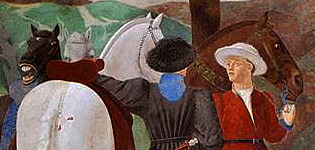 the white horse or those of his groom. One can close one’s eyes to what is most important in the world and in other people or glare in order to be narrowly comfortable and superior. It is that desire in this century, as it was in the 15th century, that is the cause of the inhumanity going on now. “The world of art is supposed to keep up with and explain what the world of life is about.” I heard Eli Siegel say this in an Aesthetic Realism Art Conference in 1956.
the white horse or those of his groom. One can close one’s eyes to what is most important in the world and in other people or glare in order to be narrowly comfortable and superior. It is that desire in this century, as it was in the 15th century, that is the cause of the inhumanity going on now. “The world of art is supposed to keep up with and explain what the world of life is about.” I heard Eli Siegel say this in an Aesthetic Realism Art Conference in 1956.
Look now at the center of this panel where Piero has painted a small person, likely a dwarf. Why has he placed her in such a pivotal position? She is the smallest figure in the panel—among the ladies-in-waiting, but lower than the others. What is her expression? She seems to be looking intently towards where the Queen is praying. Is she proud or modest? She is beautifully both. Piero accents this in the way he paints the mountain rising so high just in back of her.
And here too, in those tall regal women with their headdresses and long trains, we see a drama of high and low, pride and humility. While these ladies are of a lower rank than the Queen, they stand taller than she; their flowing trains are much more luxurious than hers; yet their horizontal waistbands lead our eye to her.
Those low trains also join the two groups, as do the colors Piero uses. Reds and greens complement and oppose. They are on the grooms and the ladies. And see how the red blanket on the white horse is balanced by the flowing white train and red gown of the lady.
Piero has the ladies-in-waiting show an incomplete attention to the Queen, relating them to the grooms in their less than complete attention.
There are dramatic relations of high and low in the travelers and the space they are part of—the rolling hills, and the trees which rise above the hills and relate the two groups of figures. The hills go up and down with a softness that both contrasts with and relates to the curved forms of the figures. These hills have a unifying color—a brown which, in its mutedness, seems to accent humility.
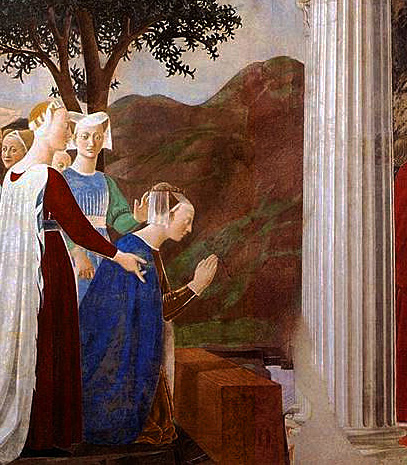 And now we come to the far right of the panel, to the exquisite figure of the kneeling Queen. In her modesty of form and color—a curving triangle—she is a thrilling contrast to the dazzling white circular form of the back of the horse. In this moment of kneeling, what is she worshipping? Something dazzling and showy? No, it is a brown three-dimensional rectangle of wood with grains of warm color painted so knowingly. We see the praying arms of the Queen, their angular shadow, the gown beneath her cape, and the hills and trees behind her, all in varied shades of brown. Then, Piero paints her cape a deeper blue than the lighter blue of the sky. Here is a humble example of how the world from which we all come, is in us. I feel that within this modesty there is grandeur.
And now we come to the far right of the panel, to the exquisite figure of the kneeling Queen. In her modesty of form and color—a curving triangle—she is a thrilling contrast to the dazzling white circular form of the back of the horse. In this moment of kneeling, what is she worshipping? Something dazzling and showy? No, it is a brown three-dimensional rectangle of wood with grains of warm color painted so knowingly. We see the praying arms of the Queen, their angular shadow, the gown beneath her cape, and the hills and trees behind her, all in varied shades of brown. Then, Piero paints her cape a deeper blue than the lighter blue of the sky. Here is a humble example of how the world from which we all come, is in us. I feel that within this modesty there is grandeur.
What does this tell us about our everyday lives? A woman standing at a table in her kitchen can prepare to cook a brown potato, see that its color is like the earth it comes from, and have a feeling of honest pride in her perception. The potato has the world’s opposites in little: it seems a humble, simple vegetable, yet we know that it can take various surprising, delectable, nourishing forms. It is an object not to be spurned but revered, because the mystery of reality is in it.
Let us linger now on the form and meaning of the divine head of the Queen of Sheba. I have had a reproduction of her on my studio wall for at least 25 years, and as I looked, I came to feel I wanted to be like her. I wanted to feel there was a logical, kind, graceful relation between myself and the world. In an Aesthetic Realism Art Conference, when I told Mr. Siegel I was having difficulty in my work about perspective, he spoke to me about these very opposites of high and low. He explained that when a person has looked down on things in order to elevate herself, to scorn things as she goes about her everyday life, she cannot just switch her purpose when she’s in front of the easel. Mr. Siegel asked me if I wanted to be able to look down with kindness. I said yes, and I think the Queen of Sheba, as she bows, is a visual lesson in how to look down with kindness, with respect.
In his essay, Eli Siegel explains: “The artist is more humble than is customary, because, as artist, he wants things to mean more and more to him; he wants to see more and more.”
Piero shows his desire to see more and more, his love of what he is painting in every brush stroke—in the soft, blending, and yet firm and sure patterns of modeling around the cheek, the nose, the eyes of the Queen. As he studied the form of the eye, he loved it. Because he loved it, he studied it more.
Look at the neck of the Queen—one of the noblest forms I have ever seen. It is strong, full, firm and gleaming. In its firmness, its clarity of outline, and its weight, it is bending forward with great humility. Look at the curves of her chin, which is both gentle and firm. As her chin goes forward and down just a little bit, it also tilts up. As form, pride is at one with humility. The whole head is like that. This woman does not thrust her chin forward in arrogant determination, nor does she draw herself back in a sulky retreat. This is not a person looking down her nose at people. Every line of the contour of her head has a glowing message: if you want to respect the world outside of you, you will be better able to put together the opposites of high and low, pride and humility.
What does it mean for us now to be proud and humble at once? It means that we see what is around us and in us in a way that is fair and has us feel we are related to, not separate and aloof from all that is different from ourselves. For instance, we, here in this room, have thoughts, memories, worries, hopes. Are we like other people? Do other people have insides as deep and mysterious as our own?
I see this work as exemplifying these sentences from “Art As, Yes, Humility”: “Art can be regarded as the successful humility of a person before the shows of existence, before existence itself. Successful humility is pride.”
II. The Resurrection
Museo Civico, Sansepolcro
I believe the deep meaning of Piero della Francesca’s great Resurrection, which we are looking at now, is one which, when it is seen, can change the lives of people in ways that are in keeping with the idea of resurrection. Aesthetic Realism shows that we can actually learn from art about our own selves.
I first heard Eli Siegel speak of the greatness of Piero in a lecture I attended in the early 1950s. He said:
Piero put together geometry and emotion, and this is what we want. We want the feeling that our blood cells have something to do with the eternal forms. If we could only relate our palpitating worries, our fearful body, to something as eternal as a triangle and sphere, it would be a comfort.
—Yes, and that is why thousands of people come to look at his paintings year after year.
Piero is painting the time when—after having been crucified, entombed, forsaken, watched over by unseeing soldiers—Christ, in the early morning, rises, comes back to life. This work, which Aldous Huxley writes of as the “greatest ever painted,” and Roberto Longhi describes as “the most sublime and transcendental of all religious themes,” I see as a symbolic representation of the two forces in people which Aesthetic Realism has described: the desire to respect the world, see meaning in it, and the desire to have contempt for it, to dismiss it, immure ourselves against it, as a means of building ourselves up.
Piero presents, in that large triangular form, these two opposing motions of the self—being energetically awake, with vivid awareness of and interest in persons and objects, and wanting to be listless, weary, bored with it all. On the one hand, there is the figure of Christ, who—rising from his tomb, newly awakened from the dead—looks out at the world before him with eyes that are deep, intense, and wide open. And at his feet are the soldiers, asleep to the miracle of life which is occurring above them. These soldiers are doing what people, unknowingly, do every day: closing their eyes to what is around them.
I’m sure that every person here has had the experience of being excited by something new or beautiful, and felt another person was not so interested. And likely we’ve also been in the other position—of being unresponsive to another’s enthusiasm. In Aesthetic Realism consultations I’ve been told often by a wife that she tried to tell her husband about something important to her, and felt he wasn’t listening. And many a husband has left off telling his wife about something that matters to him because, sadly, he feels she won’t appreciate its meaning. How often have you had to ask someone talking to you, while your mind was elsewhere, “What did you say?” How many times have you seen a child saying to its mother, “Look, look, mama,” and the mother is elsewhere in her mind, or on her cell phone? These common instances are forms of everyday contempt, which, surprising as it may seem, comment on this grand work of Piero.
Opposites central in the idea of resurrection—the coming to be of life out of death—are Repose and Energy. In Eli Siegel’s historic Fifteen Questions of 1955, Is Beauty the Making One of Opposites? he asks:
Is there in painting an effect which arises from the being together of repose and energy in the artist’s mind?—can both repose and energy be seen in a painting’s line and color, plane and volume, surface and depth, detail and composition?—and is the true effect of a good painting on the spectator one that makes at once for repose and energy, calmness and intensity, serenity and stir?
Energy is in the risen Christ, that upright, strong figure with that triumphant banner. He is vibrantly awake. The surprising color of his robe is that new-born pink. Pink puts opposites together—it is an almost lighthearted oneness of the energy of red and the quietude of white. I believe that the deep sense of satisfaction people have felt standing before this painting comes from the way he puts together intensity and calm.
See how Christ’s hand rests on his raised knee, and his firmly placed, fleshy foot is ready to step forth from the stone ledge of the tomb. Piero paints, in every detail, a most subtle and convincing relation between the repose and energy in Christ and in the world around him.
Though Christ is standing still, the folds of his robe are in motion, and related to the cylindrical forms of his fingers holding the robe, and to the dark, vertical trees rising on either side of him. And look: the small creases of flesh at his waist, which are signs of a body in motion, are like the horizontal clouds in the sky.
He has risen with grace and with one purpose—to see. And to see, Aesthetic Realism states with beautiful certainty, is the purpose of art and it is success in life. We feel, in how Christ is painted, that he has a tremendous desire to see, and we also know from his face that he has not forgotten all that he has seen. He is not smooth: his face is rough, his cheeks are worn with care, he has a rough beard. There is a simultaneous presence of sorrow and courage.
Now look at the sleeping soldiers beneath him. What do they mean? What can they tell us about ourselves? These soldiers do not want to see. Their legs and arms are so crossed that movement is impeded. Theirs is restfulness not for the purpose of more energy, but for the purpose of willful denial. And yet as Piero paints the angles of their limbs, he makes us feel motion and energy. There is a relation of rest and motion in the colors. The energy of red interweaves with a restful green. The robes of the soldiers go from green, to quiet brown, to green; with red on a hat above, a leg below, green on a foot, green on a helmet. There is the simultaneous impact of rest and motion, rising and falling as Piero relates these opposites in his careful way.
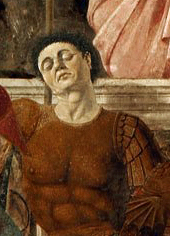
Famously, it has been noted that Piero has painted himself here, as as he did in the Misericordia and perhaps elsewhere. There he is, bareheaded, without the hard, covering helmet. He is resting, with eyes shut, on the edge of the stone tomb. I believe, as courageous artist, he wanted to show that aspect of himself he saw as not so noble, not so divinely impelled.
At the same time, his head becomes part of the pole Christ carries aloft, with its red cross. Perhaps Piero is saying: “I, in my seeingness and unseeingness, stand for humanity.”
And so it moves me very much to have spoken about works I love, and that now, over 500 years since Piero lived, we can see more through Aesthetic Realism about their meaning for the world and ourselves.

